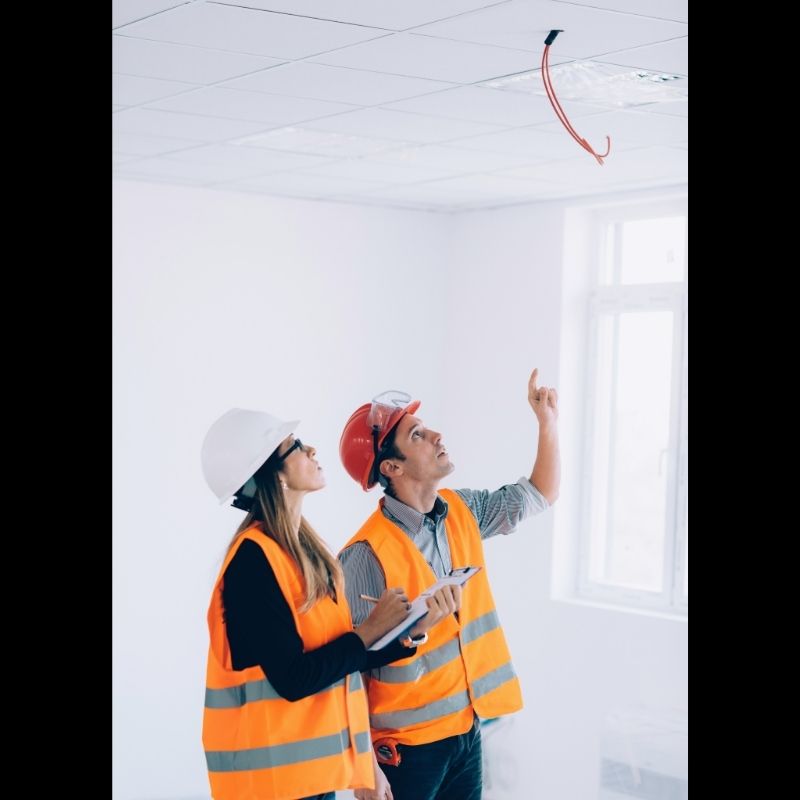
Whether the fire alarm system is more than a decade old or newly installed, fire alarm maintenance must always be an ongoing priority. Forgetting to test and repair your alarm system can result in loss of life, physical injuries, and extensive property damage.
Finding a Fire Alarm Maintenance Partner
If you have not already done so, working with a qualified, trustworthy fire alarm service company to partner with is an essential first step. The company should be fully licensed and recognized for their expertise in designing, installing, maintaining, and repairing every element of the fire alarm system.
Establishing an ongoing fire alarm maintenance program allows building owners and facilities supervisors to focus on other operational details of a large building or campus. Detection and notification systems are complex and should not be serviced nor repaired by your regular maintenance personnel. Fire and smoke sensors are delicate and often connected wirelessly to an intricate security network. Any improper adjustment can jeopardize the protection the systems should provide.
Ongoing Testing and Maintenance
Frequent inspection of the fire detection and notification systems are vital to the safety of the occupants and contents of the building or campus. Local authorities may only require a certification of testing once per year, but many elements of the system should be tested, inspected, and documented more frequently.
System components, like any other mechanical devices, accumulate dust and grime over time. Parts tend to wear out with age. Systems can malfunction as a result and create problems that can be fatal. Professional fire alarm maintenance experts know where to look and can identify elements that must be cleaned or replaced.
Thorough testing by trained professionals will signal any malfunction in the system and location of the problem. The results guide the specialist to repair or replace any device or part that will solve the problem.
Your fire alarm maintenance partner has the technical skills and training to manage procedures, which can be as complicated as the proper cleaning of delicate smoke detection devices to the not so complicated replacement of notification devices and control panels.
Recording All Maintenance Activities
All maintenance activity or adjustments to any elements of the fire alarm systems should be recorded and filed with installation documents and manufacturer operations and maintenance instructions. This information is necessary for subsequent service personnel to understand the existing conditions and for fire alarm system inspectors to monitor all work performed.
The maintenance specialist should record any deficiencies encountered and the actions taken to remedy the situation.
Objectives of Professional Fire Alarm Inspections and Maintenance
Your fire alarm maintenance company will provide regular maintenance to ensure your systems are in perfect order for quick notification of occupants. These devices must also alert local emergency personnel to a potential smoke or fire event. Also, proper maintenance will make sure the systems meet the requirements of the:
- National Fire Prevention Association
- Local agency having jurisdiction
- Manufacturer’s recommended inspection frequency and standards
- Annual system inspection
Visual Inspection
A visual inspection of the components may identify obvious problems such as loose wiring, damaged outer casings or, in some systems, determine the cause of unwarranted warning notifications. Closer examination of the physical condition of control panels, smoke detection equipment, warning devices, and any fire suppression equipment is essential to detect damage caused by vandalism or other factors. Emergency related systems like access control, elevator recall, and HVAC shutdown must also be inspected and tested regularly.
Maintenance experts and fire officials will also look for excessive accumulations of soot and grime that may impair the normal function of the fire detection systems.
Fire Alarm Systems Testing
Inspectors will always look for irregularities that affect normal operations of the detection and notification systems. Modifications to the intended design can be very dangerous, resulting in overall system failure. Moreover, when delicate smoke detection equipment has been manually altered or exposed to a harsh environment, the devices may not work when needed.
Inspection Checklist
Qualified fire alarm maintenance experts will perform detailed testing during their maintenance visits to ensure all systems are in a fully operational condition in case of emergency. The annual testing process which is required by local and national authorities is rigorous, so maintenance procedures should make sure that systems will not fail. A complete inspection involves the following elements:
- Control Panel: The control panel is the heart of the entire system. In larger buildings and with today’s connectivity, the control panel links all devices within the system to a central monitoring location and the local fire department.
- Circuitry: The licensed technician should inspect for wear and tear or possible disconnections. In a wired system, the effectiveness of the entire network is dependent on the connections being sound.
- Detectors: Smoke detectors are often the first line of defense against the threat of fire. These devices work with either photoelectric or infrared detection techniques or both. To test, the technician will introduce an aerosol designed for this purpose to determine if the detection systems are working. If the detectors do not react, they may need to be replaced or repaired. In any case, the technicians should thoroughly clean the detectors to ensure the highest level of sensitivity.
- Manual Alarm Pull Stations: In systems where manual pull levers operate fire alarms, handles should be activated to determine that they are working properly. If alarms do not respond, the technician will replace the device immediately.
- Heat Detectors: As another line of defense, sometimes heat detection will activate sensors before smoke is detected. Therefore, the testing personnel should test each device by applying heat to the sensor area to make sure these function as needed. During maintenance visits, the sensors should be cleaned or replaced to ensure quick detection and notification when required.
- Notification Devices: Modern warning devices are more than alarms. Supplementing the traditional alarm bells with horns or prerecorded audible directions that guide individuals to safe areas or evacuation zones. Visual notification devices are also available. These may utilize LED, prerecorded visual instructions directing people to evacuation routes.
- Auxiliary Power Sources: Auxiliary power sources are critical elements of a fire alarm system. Making sure the batteries or backup electrical source is an essential part of any fire alarm system.
- Battery Chargers: When batteries are the primary or backup source of power for the system, the technician should inspect and test the charger regularly to make sure it is operational.
- Door and Damper Releases: In the case of fire emergencies, doors should automatically unlock for quick evacuation. Dampers in the building should shut to prevent the potential expansion of the danger.
- Annunciators: Checking the annunciators to make sure they accurately portray the location of each fire alarm and smoke detector in the building is essential. This equipment must be located near the entrances of the building to give the entering emergency personnel a clear map of the emergency devices.
- Central Monitoring: The inspection process will check if and how quickly the central emergency department will receive the signal from the building’s emergency alert system. In any emergency, quick response is crucial to minimize the potential for injury or damage.
- Detection Devices in Elevator Shafts and Secondary Areas: Testing smoke and heat detection devices in locations like elevator shafts, utility rooms, storage areas, and annexes is necessary since these are possible locations of fire outbreak.
Regular Preventative Maintenance
It is no coincidence that a regular, professional maintenance program sounds very much like an annual inspection. While the inspection is an annual event required by the local authorities, some of these steps should be part of the regular maintenance cycle by a licensed fire alarm maintenance company.
Contact High Rise Security Systems
High Rise Security Systems, a Premier Distributor of NOTIFIER™️ by Honeywell fire detection systems, provides maintenance and testing services for all types of fire alarm systems. Certified by UL and NICET (National Institute for Certification in Engineering Technologies), HRSS experts are fully trained and licensed.
HRSS has been providing professional fire alarm services for over 30 years. The company offers state-of-the-art equipment and support to protect all buildings from high-rise office structures to sprawling medical facilities and university campuses.
HRSS employs state-of-the-art design techniques to collaborate on new construction and retrofit projects. Our fire safety specialists integrate fire protection systems with access control and security networks to provide complete protection for building occupants. Contact us for safety and peace of mind with a thorough, professional, licensed fire alarm system maintenance inspection.



